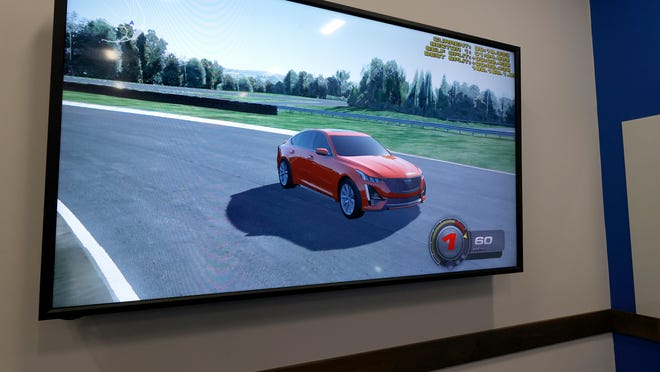Many Michiganders have heard of it, but few have seen it and even fewer ever will.
I’m talking about General Motors Milford Proving Ground. The site straddles Oakland and Livingston counties and sits tucked away about 4 miles from the tiny village of Milford and a good 45-minute drive west from the big city of Detroit.
The proving ground is a historic place, about to turn 100 years old next year. It is home to deer, foxes, eagles and pretty much all of GM’s top-secret future products. The vehicles GM sells throughout the world are partly developed and thoroughly tested at the proving ground by some of the best drivers and engineers in the world. These folks are the Top Guns of driving, capable of evaluating every performance aspect of the car while taking laps around a racetrack at speeds that can top 150 mph.
The site is also a staple of economic stability for the surrounding communities that rely on the 4,900 workers there for revenue.
More:GM Proving Ground in Milford is full of secrets — and few employees get to see it
Here are some of the more interesting facts about GM’s top secret development site:
- What it cost: GM paid about $100,000 for the property in 1923. It has grown to occupy about 4,000 acres of land and has lakes, where employees can fish. It’s teaming with wildlife and contains the highest point in Oakland County.
- No “S” on the end: The full name of the site is the General Motors Milford Proving Ground. But like Meijer, Kroger or Ford Motor Co., Milford Proving Ground also falls victim to many Michiganders putting an “S” on the end of it that does not belong there, calling it the “proving grounds.” It is not plural.
- Top secrets: There are secret labs with state-of-the-art virtual technology where engineers can drive on the moon and do the GMC Hummer EV’s famous CrabWalk long before the vehicle ever did it on the road.
- Like a city with services: The site, which operates 24/7 365 days a year, is self-contained, using its own wells for water; it has a wastewater treatment facility and it employs certified firefighters, licensed EMTs, hazardous materials response, confined space rescue team and road patrol officers. It has a fully staffed medical department.
- Why you won’t get in: The site is heavily guarded because all of GM’s prototypes of future cars are there, hidden from spy photographers either behind closed doors, under camouflage tape or — for super top-secret projects — tested only in the dark of night to shield it from drone photos.
- Special driver licenses needed: The engineers who work at the grounds are trained to drive like professional race car drivers so that they can test vehicles to the limits. The level of license is based on the speed a driver is allowed to go. GM has about 81,000 salaried employees globally, but fewer than 100 have passed the driving tests to do the top-speed test driving at the proving ground.
- How many miles of tracks: There are 147 miles of test courses, including the Milford Road Course, a racetrack that mimics parts of the famous Nurburgring in Germany.
- Every kind of roadway: The road surfaces of GM’s tracks vary from dirt roads, to hills, to bumpy concrete with purpose-made potholes, to six lanes of banked concrete on a 5-mile Circle Track, to a straightaway with no speed limit, to the speedway-ready 3-mile Milford Road Course.
- What that asphalt is: The ground’s “Black Lake” is a slab of black asphalt that in the sunlight gives the illusion that it is water. It is the size of 59 football fields and is one of the largest vehicle dynamics pads in the world, used for a variety of tests on various aspects of cars, such as vehicle handling.
- Replica of Belgian road: One of the smaller test tracks that is no less intriguing is GM’s Belgian Block. It is a 2-mile-long replica of the real brick road that ran from Antwerp to Brussels, which was discovered during World War I by U.S. soldiers.
- Hollywood knows about it: Portions of the “Transformers 4” movie were filmed at the proving ground. The filming locations included the Oval Track and the North/South Straightaway course. The Oval Track was painted with road markings to transport it fictionally to Asia.
- Where guardrails were born: The 130 miles of guardrails that line nearly every road on the proving ground reflect what you see along any major interstate. The rails were first developed at Milford Proving Ground, designed to absorb an impact and pull a car along the rail.
- Developing virtual technology: GM is investing millions in virtual technology to test the entire car’s performance virtually before ever making a physical prototype and putting it on the road. Virtual technology can get new vehicles to market faster, saving millions of dollars in costs to build physical prototypes. One prototype of a car can cost $100,000.
More:GM salaried workers should expect smaller bonuses: How formula works
More:GM looks to hire tech talent from massive job cuts in Silicon Valley
Contact Jamie L. LaReau: jlareau@freepress.com. Follow her on Twitter @jlareauan.
Read more on General Motors and sign up for our autos newsletter. Become a subscriber.
